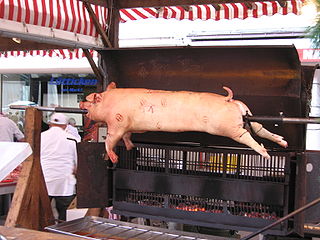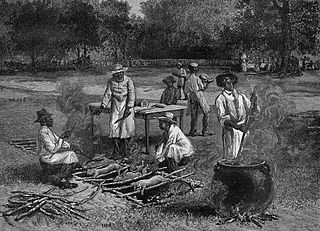
Grilling is a form of cooking that involves dry heat applied to the surface of food, commonly from above, below or from the side. Grilling usually involves a significant amount of direct, radiant heat, and tends to be used for cooking meat and vegetables quickly. Food to be grilled is cooked on a grill, using a cast iron/frying pan, or a grill pan.

Smoking is the process of flavoring, browning, cooking, or preserving food by exposing it to smoke from burning or smoldering material, most often wood. Meat, fish, and lapsang souchong tea are often smoked.

Outdoor cooking differs substantially from kitchen-based cooking, the most obvious difference being lack of an easily defined kitchen area. As a result, campers and backpackers have developed a significant body of techniques and specialized equipment for preparing food in outdoors environments. Such techniques have traditionally been associated with nomadic cultures such as the Berbers of North Africa, the Arab Beduins, the Plains Indians and pioneers of North America, and have been carried down to and refined in modern times for use during recreational outdoors pursuits.

Hāngi is a traditional New Zealand Māori method of cooking food using heated rocks buried in a pit oven, called an umu. It is still used for large groups on special occasions.

A luau is a traditional Hawaiian party or feast that is usually accompanied by entertainment. It may feature food such as poi, Kalua pig, poke, lomi salmon, opihi, and haupia, beer, and entertainment such as traditional Hawaiian music and hula. Among people from Hawaiʻi, the concepts of "luau" and "party" are often blended, resulting in graduation luaus, wedding luaus, and birthday luaus.

The clambake or clam bake, also known as the New England clambake is a traditional method of cooking seafood, such as lobster, mussels, crabs, soft-shell clams, and quahogs. The food is traditionally cooked by steaming the ingredients over layers of seaweed. The shellfish can be supplemented with vegetables, such as onions, carrots, and corn on the cob. Clambakes are usually held on festive occasions along the coast of New England.

The cuisine of Hawaii incorporates five distinct styles of food, reflecting the diverse food history of settlement and immigration in the Hawaiian Islands. In the pre-contact period of Ancient Hawaii, Polynesian voyagers brought plants and animals to the Islands. As Native Hawaiians settled the area, they fished, raised taro for poi, planted coconuts, sugarcane, sweet potatoes and yams, and cooked meat and fish in earth ovens. After first contact in 1778, European and American cuisine arrived along with missionaries and whalers, who introduced their own foods and built large sugarcane plantations. Christian missionaries brought New England cuisine while whalers introduced salted fish which eventually transformed into the side dish lomilomi salmon.

Pachamanca is a traditional Peruvian dish based on the baking, with the aid of hot stones, of lamb, mutton, alpaca, pork, chicken or guinea pig, marinated in spices. Other Andean produce, such as potato, green lima beans or "habas", sweet potato, occasionally cassava or yuca, and humitas as well as ears of corn, tamale and chili, is included in the baking.

Char siu is a popular way to flavor and prepare barbecued pork in Cantonese cuisine. It is classified as a type of siu mei (燒味), Cantonese roasted meat.

Barbecue varies by the type of meat, sauce, rub, or other flavorings used, the point in barbecuing at which they are added, the role smoke plays, the equipment and fuel used, cooking temperature, and cooking time.

An earth oven, ground oven or cooking pit is one of the simplest and most ancient cooking structures. At its most basic, an earth oven is a pit in the ground used to trap heat and bake, smoke, or steam food. Earth ovens have been used in many places and cultures in the past, and the presence of such cooking pits is a key sign of human settlement often sought by archaeologists. Earth ovens remain a common tool for cooking large quantities of food where no equipment is available. They have been used in various civilizations around the world and are still commonly found in the Pacific region to date.

Laulau is a Native Hawaiian cuisine dish. The traditional preparation consisted of pork wrapped in taro leaves. In old Hawaiʻi, laulau was assembled by taking a few leaves and placing a few pieces of fish and pork in the center. In modern times, the dish uses taro leaves, salted butterfish, and either pork, beef, or chicken and is usually steamed on the stove. Laulau is a typical plate lunch dish and is usually served with a side of rice and macaroni salad.

The banana leaf is the leaf of the banana plant, which may produce up to 40 leaves in a growing cycle. The leaves have a wide range of applications because they are large, flexible, waterproof and decorative. They are used for cooking, wrapping, and food-serving in a wide range of cuisines in tropical and subtropical areas. They are used for decorative and symbolic purposes in numerous Hindu and Buddhist ceremonies. In traditional homebuilding in tropical areas, roofs and fences are made with dry banana-leaf thatch. Banana and palm leaves were historically the primary writing surfaces in many nations of South and Southeast Asia.

A pig roast or hog roast is an event or gathering which involves the barbecuing of a whole pig.

In the United States, barbecue refers to a technique of cooking meat outdoors over a fire; often this is called pit barbecue, and the facility for cooking it is the barbecue pit. This form of cooking adds a distinctive smoky taste to the meat; barbecue sauce, while a common accompaniment, is not required for many styles.
Fijian cuisine has traditionally been very healthy. Fijians prefer a more tuber and coconut based diet. High caloric foods are good for hard-working villagers who need extra calories while working on their farms but this causes a range of chronic illness such as obesity. Fiji is a multicultural country and is home to people of various races. In most Fijians' homes, food of other cultures is prepared on a regular basis such as Indian curries and Chinese dishes. Fiji is also famous for its seafood.

A pit barbecue is a method and constructed item for barbecue cooking meat and root vegetables buried below the surface of the earth. Indigenous peoples around the world used earth ovens for thousands of years. In modern times the term and activity is often associated with the Eastern Seaboard, the "barbecue belt", colonial California in the United States and Mexico. The meats usually barbecued in a pit in these contexts are beef, pork, and goat.

Balinese cuisine is a cuisine tradition of Balinese people from the volcanic island of Bali. Using a variety of spices, blended with the fresh vegetables, meat and fish. Part of Indonesian cuisine, it demonstrates indigenous traditions, as well as influences from other Indonesian regional cuisine, Chinese and Indian. The island's inhabitants are predominantly Hindu and culinary traditions are somewhat distinct with the rest of Indonesia, with festivals and religious celebrations including many special foods prepared as the offerings for the deities, as well as other dishes consumed communally during the celebrations.

Native Hawaiian cuisine is based on the traditional Hawaiian foods that predate contact with Europeans and immigration from East and Southeast Asia. The earliest Polynesian seafarers are believed to have arrived on the Hawaiian Islands in 300–500 AD. Few edible plants were indigenous to Hawaii aside from a few ferns and fruits that grew at higher elevations. Various food-producing plants were introduced to the island by migrating Polynesian peoples.

















